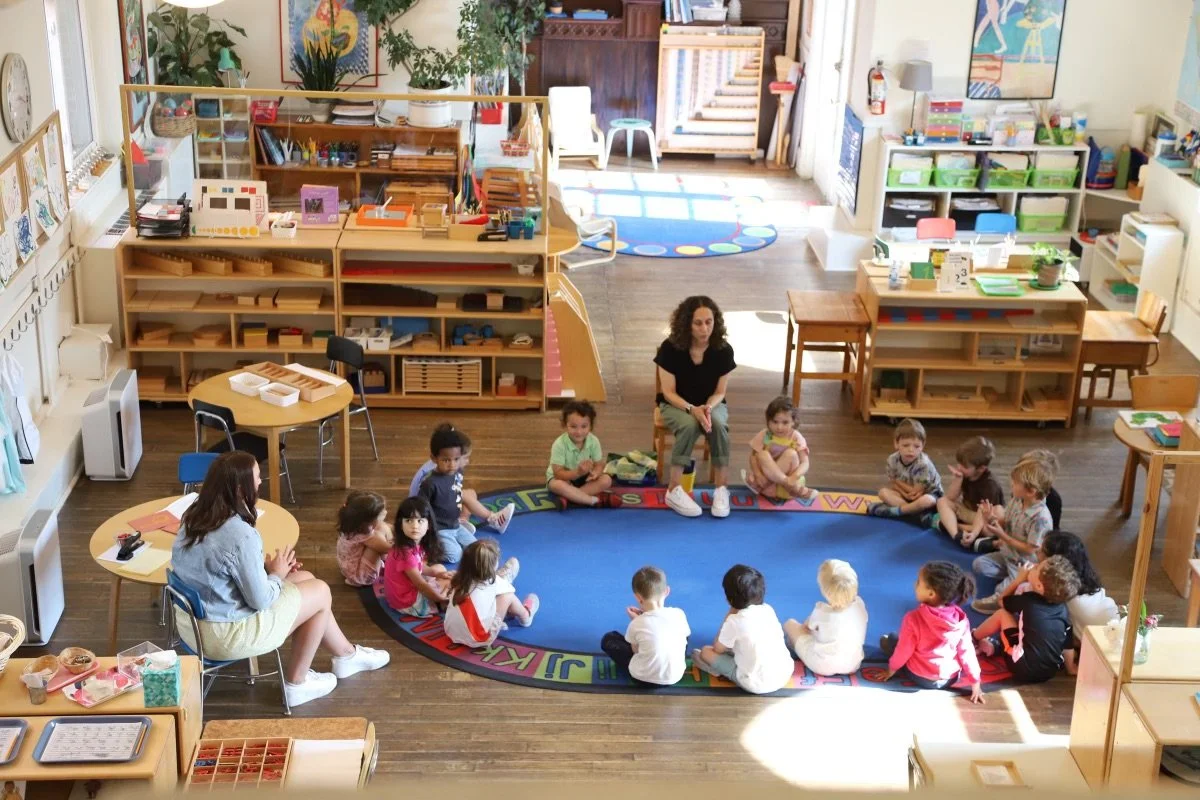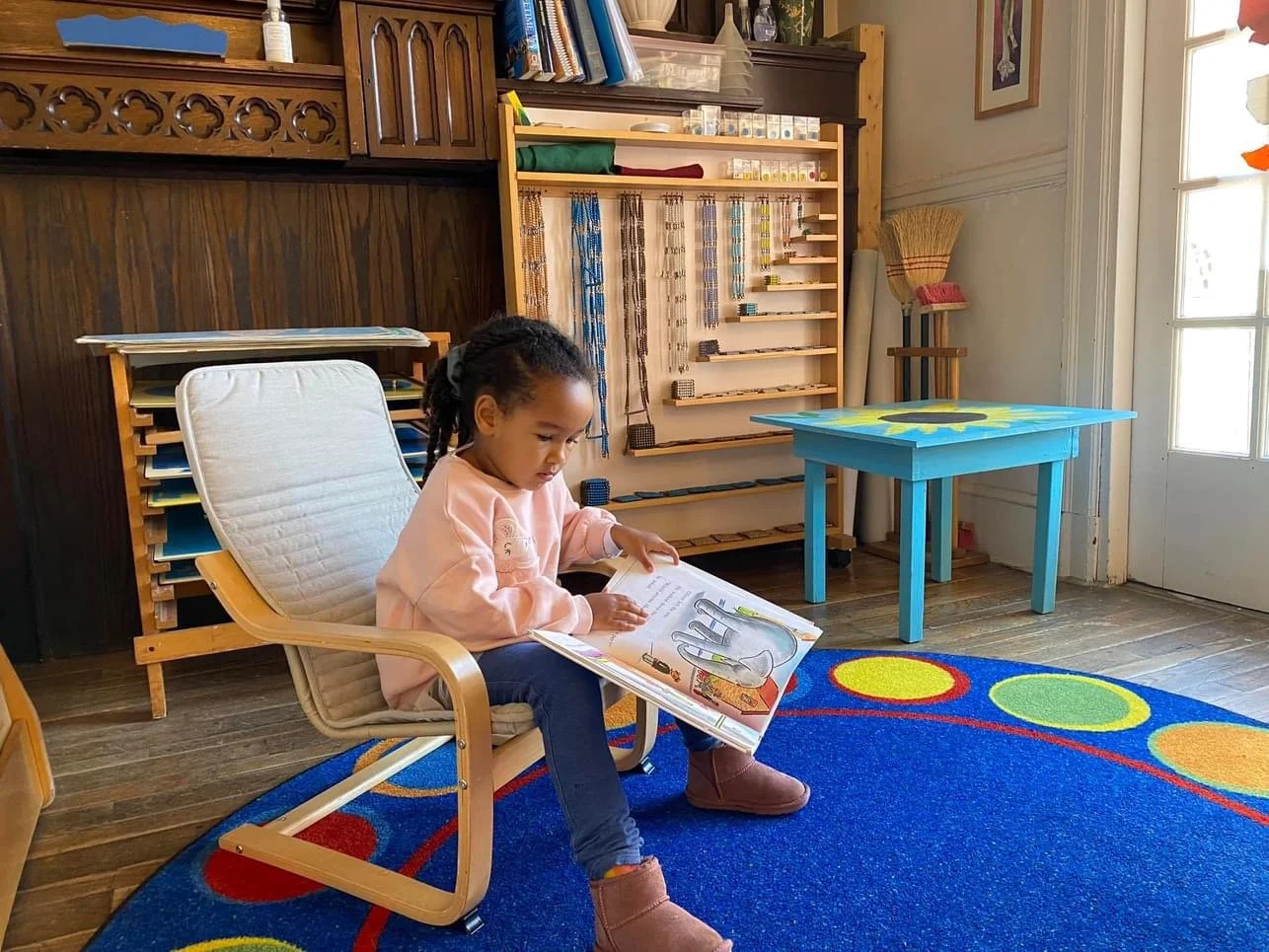Curriculum
The Georgetown Montessori School, established in 1983, provides the "prepared environment" essential to a Montessori education. The materials are designed to provide the child with concrete examples of abstract ideas.
Children are free to move around, are stimulated by purposeful learning activities of their own choosing, can discover and correct their own errors, and are treated with respect and trust.
The materials are programmed, as each piece prepares the child to take another step ahead in his learning, progressing from the simple to the complex, from the concrete to the abstract.
After having a lesson from a trained Montessori teacher, the actual learning takes place when the child voluntarily begins a repetition of the work. It is this repetition that develops the child’s concentration and internal feeling of success and accomplishment.
A Montessori environment allows for independent work and freedom to choose. The self-correcting function of the Sensorial materials combined with the freedom to choose and to work independently collectively facilitate developing executive functioning skills.
The Georgetown Montessori School consists of a Toddler Program and a Primary Program.
TODDLER PROGRAM
The Toddler Program consists of 12 children with 1 Montessori Teacher and 2 assistants. There is a three morning, five morning or five full day option.
The children in our Toddler program begin at age 24 months and continue until they are approximately three years old. They begin in September and remain in the class the entire school year. Classes meet three consecutive (Tuesday, Wednesday and Thursday) or five mornings weekly. This is your child's first school experience. The classroom consists of two rooms, one being for gross motor movement and the other with Montessori practical life, sensorial and beginning language and math materials.
The toddlers develop in the areas of language, movement, independence and socialization. The morning curriculum consists of independent "work time" , morning circle time, group snack time , outdoor play time and closing circle time . There is a weekly music class of movement and using instruments. Introduction to different foods and food preparation is also included in the curriculum.
Individual work time focuses on practical life skills, grace and courtesy, social skills, sensorial exploration, art activities, and beginning language and math lessons.
PRIMARY PROGRAM
The Primary Program is a class of approximately 25 children of mixed ages ( 3 - 6 years) with three Montessori trained teachers and one assistant.
The Montessori education philosophy emphasizes the importance of mixed-age classrooms, where children remain in the same class for a span of multiple years. This practice allows younger children to learn from older peers and older children to reinforce their learning by teaching younger ones.
Staying in the same classroom for three years enables children to develop strong relationships with their teachers and classmates, fostering a sense of security and belonging. They also have the opportunity to work at their own pace and delve deeper into subjects that interest them, as the Montessori approach values individualized learning.
By progressing from being the youngest to the oldest in the class, children gain confidence and leadership skills over time. They learn to collaborate, communicate effectively, and become more independent learners. This confidence and self-assurance can serve them well as they transition to the next stage of their education or life beyond school.
It emphasizes the following areas:
Practical Life Exercises: Polishing, washing, pouring, lacing, tying, spooning, buttoning ones's coat, as well as grace and courtesy lessons (saying “excuse me”, “thank you” etc.). These practical life lessons assist the child's independence and ability to care for his or her own needs. Such real activities help develop large and small muscle coordination, orderly work habits and deep concentration which are necessary for the further development of academic skills.
Sensorial Exercises: These exercises help the children become aware of the world around them. The exercises are designed to help the child isolate, compare and classify perceptions of sounds, smells, colors, textures, sizes and shape using concrete materials. They are materialized abstractions showing length, height, breadth, weight etc. They progress naturally to art, music, geography, history and plant and animal studies.
Language: Reading is taught phonetically using sandpaper letters. It begins with writing, using the movable alphabet and develops into phonetic reading using various reading cards and books. It gradually encompasses all forms of language including parts of speech, phonograms, grammar and spelling. Many exercises are introduced that assist the development of fine motor skills which are necessary for writing.
Mathematics: The Montessori approach to teaching math is a basic one, beginning with concrete materials and moving to the abstract ideas. The curriculum proceeds from learning quantities, matching symbols to the quantities, the decimal system (units, tens, hundreds, thousands), linear counting, addition, subtraction, multiplication and division and fractions.
Geography: The children learn the continents of the world as well as the countries of these continents and work with the puzzle maps of each continent. They also see visual impressions of the different continents and cultures, flags and music. We are very lucky to have an international community at Georgetown Montessori so we often invite parents to present cultural events from their country.
Music: Music is a part of our everyday circle time. A special music class with a professional music teacher is also offered once a week, allowing many opportunities for movement and singing. We also have a variety of small musical instruments that children are free to explore.
Art: Art is offered in the classroom daily, providing an introduction to different mediums including watercolor, easel painting, collage, color mixing, pastels, acrylic painting and play dough. Also offered are seasonal activities (leaf and stone collage, pumpkin painting, ice painting, rock painting, watercolor drip painting and making footprints and handprints).
Children in the Primary program typically remain for three years. The culmination of the lessons in a Montessori classroom is seen in the child's third year in a Montessori program. The third year child has the valuable experience of being a leader in the classroom which gives the child the self confidence to go on to their next educational experience.
The Bead Stair
The Reading Nook
A Child’s Map of North America and South America
A Child’s Artwork








